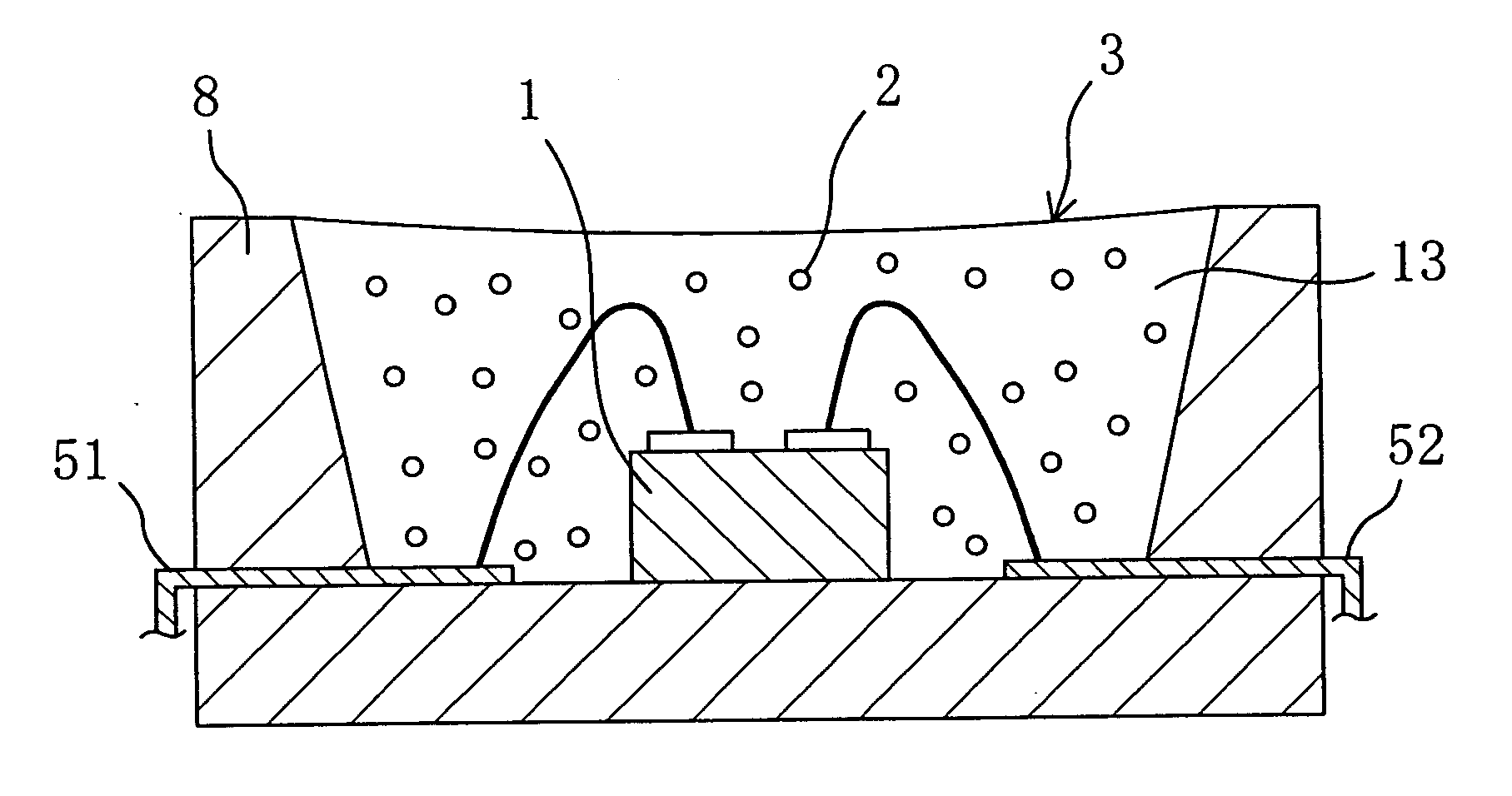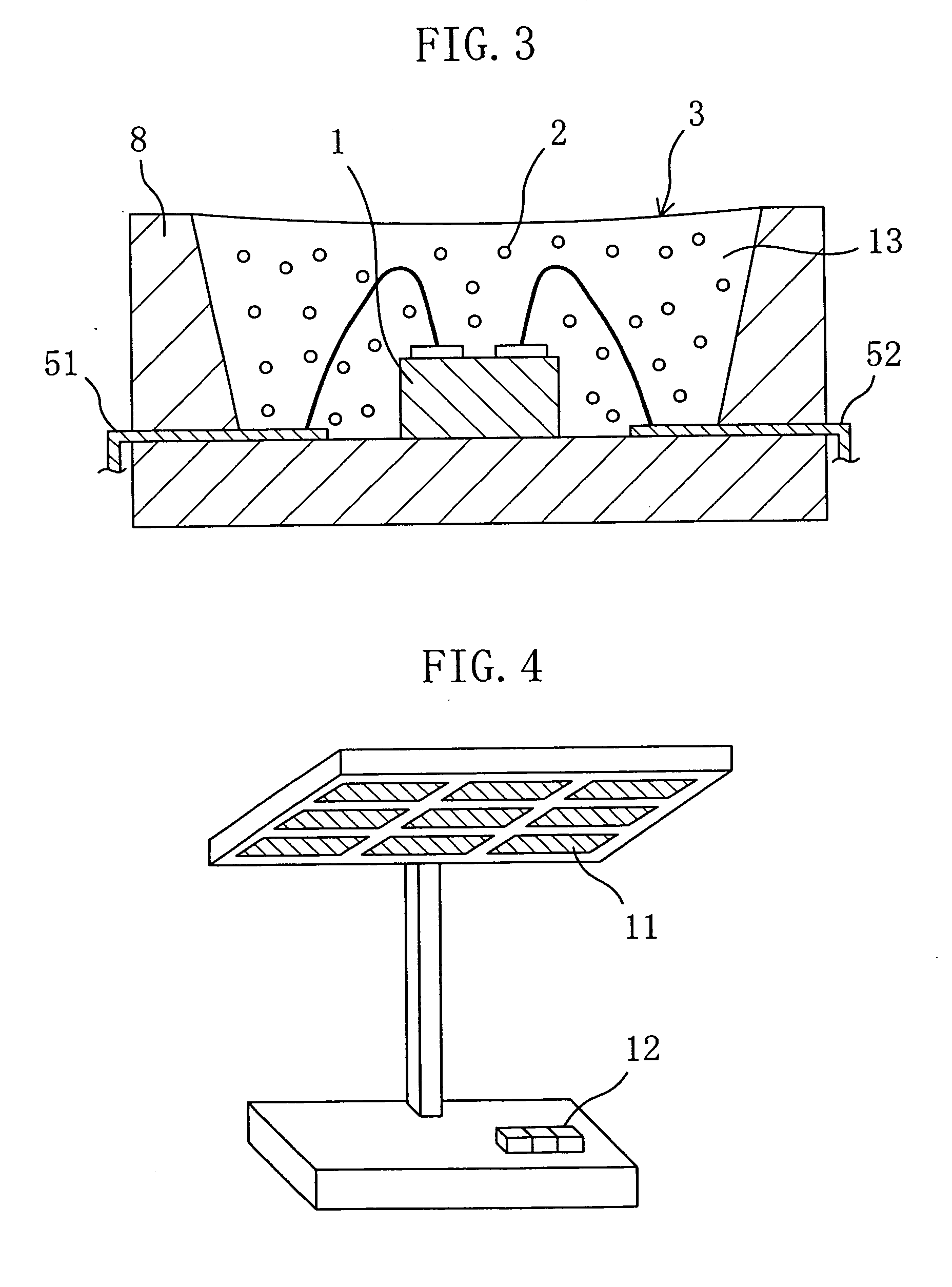Light-emitting semiconductor device, light-emitting system and method for fabricating light-emitting semiconductor device
- Summary
- Abstract
- Description
- Claims
- Application Information
AI Technical Summary
Benefits of technology
Problems solved by technology
Method used
Image
Examples
embodiment 1
[0164] Hereinafter, a first embodiment of the present invention relating to a light-emitting semiconductor device and a method for suppressing color unevenness in the light-emitting semiconductor device will be described with reference to the drawings.
[0165]FIG. 1 is a vertical cross-sectional view showing a first exemplary light-emitting semiconductor device as a relatively typical example of this embodiment. As shown in FIG. 1, the first exemplary light-emitting semiconductor device is a chip-type light-emitting semiconductor device including: a substrate 4 (a submount element) functioning as a Zener diode; a flip-chip-type blue LED 1 mounted on the substrate 4 to be electrically connected to the Zener diode in the substrate; and a luminescent layer 3 encapsulating the blue LED 1 and made of a mixture of yellow / yellowish phosphor particles 2 and a base material 13 (a translucent resin). The blue LED 1 has a main light-extracting surface facing upward as shown in FIG. 1. The lumin...
embodiment 2
[0239] Now, an embodiment of a light-emitting system according to the present invention is described with reference to the drawings.
[0240] Various kinds of displaying systems using light-emitting semiconductor devices (e.g., LED information display terminals, LED traffic lights, LED stoplights of vehicles and LED directional lights) and various kinds of lighting systems (e.g., LED interior / exterior lights, courtesy LED lights, LED emergency lights, and LED surface emitting sources) are herein defined broadly as light-emitting systems.
[0241]FIGS. 4 through 6 are perspective views respectively showing examples of a light-emitting system according to a second embodiment of the present invention. FIG. 4 is a perspective view schematically showing a configuration of a desk-lamp-type lighting system as a first exemplary light-emitting system of the present invention.
[0242] As shown in FIG. 4, the first exemplary light-emitting system includes: a lighting unit in which a large number of...
embodiment 3
[0427] In this embodiment, a method for forming a thin luminescent layer is described. According to this embodiment, yellow / yellowish phosphor particles which are expressed by the chemical formula (Sr1-a1-b1-xBaa1Cab1Eux)2SiO4 where the values a1, b1 and x are in the ranges 0≦a1≦0.3, 0≦b1≦0.8 (more preferably 0≦b1≦0.6) and 0<x<1, respectively, and which emit light having an emission peak in the wavelength range from 550 nm to 600 nm, both inclusive, are densely distributed near a light-emitting diode, so that a luminescent layer is made thin, i.e., the thickness through which light passes is reduced, thereby reducing attenuation of light. For example, this embodiment is for a method for fabricating a light-emitting semiconductor device in which a luminescent layer has a substantial thickness in the range from 50 μm to 1000 μm, both inclusive, where a light extraction surface of a blue-light-emitting device is located.
[0428] Hereinafter, examples of the fabrication method will be de...
PUM
 Login to View More
Login to View More Abstract
Description
Claims
Application Information
 Login to View More
Login to View More - R&D
- Intellectual Property
- Life Sciences
- Materials
- Tech Scout
- Unparalleled Data Quality
- Higher Quality Content
- 60% Fewer Hallucinations
Browse by: Latest US Patents, China's latest patents, Technical Efficacy Thesaurus, Application Domain, Technology Topic, Popular Technical Reports.
© 2025 PatSnap. All rights reserved.Legal|Privacy policy|Modern Slavery Act Transparency Statement|Sitemap|About US| Contact US: help@patsnap.com



